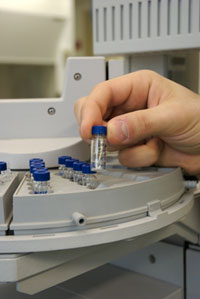Delignification for Xylan for Enzymatic Hydrolysis
Who’s Involved?
 Research Introduction
Research Introduction
In order to use the sugar content of hemicellulose, a major wood constituent, for generation of new products, such as ethanol or plastics, interference from lignin, another major wood component, must be eliminated. Conversely, to make use of the lignin, the sugars must be removed. We are examining methods for accomplishing both of these tasks selectively.
Research Details
We now have shown that aryl glycosides modeling the presumed connection between lignin and hemicellulose can be cleaved selectively by superoxide ion, generated at pH 12 by photolysis of hydrogen peroxide. The aromatic lignin component is oxidized all the way to carbon dioxide, which has been identified by head space gas chromatography coupled with mass spectrometry. Very little oxidation of the sugars occurs. We also find that p-methoxyphenyl ?-D-glucoside is oxidized by the laccase from T. versicolor to give cleanly ?-D-glucose and p-methoxyphenol. The phenol is then further oxidized to dimers, which are being characterized. Both of these results demonstrate the feasibility of selective delignification of hemicelluloses.
Other Research Partners
In addition to support from the FBRI, this project is also funded by the USDA through the WUR grant. Mai Nguyen (PhD candidate), Raju Kovur (MS candidate), and Venkata Makkena (MS candidate) are working on the problem in addition to Dylan Montgomery (MS candidate), who was supported by the FBRI last summer as an undergraduate.
What’s New on this Project?
Work with model compounds indicates successful delignification both enzymatically and using superoxide at pH 12. Some success has been achieved also with the xylan, although the products of delignification have not yet been characterized.
